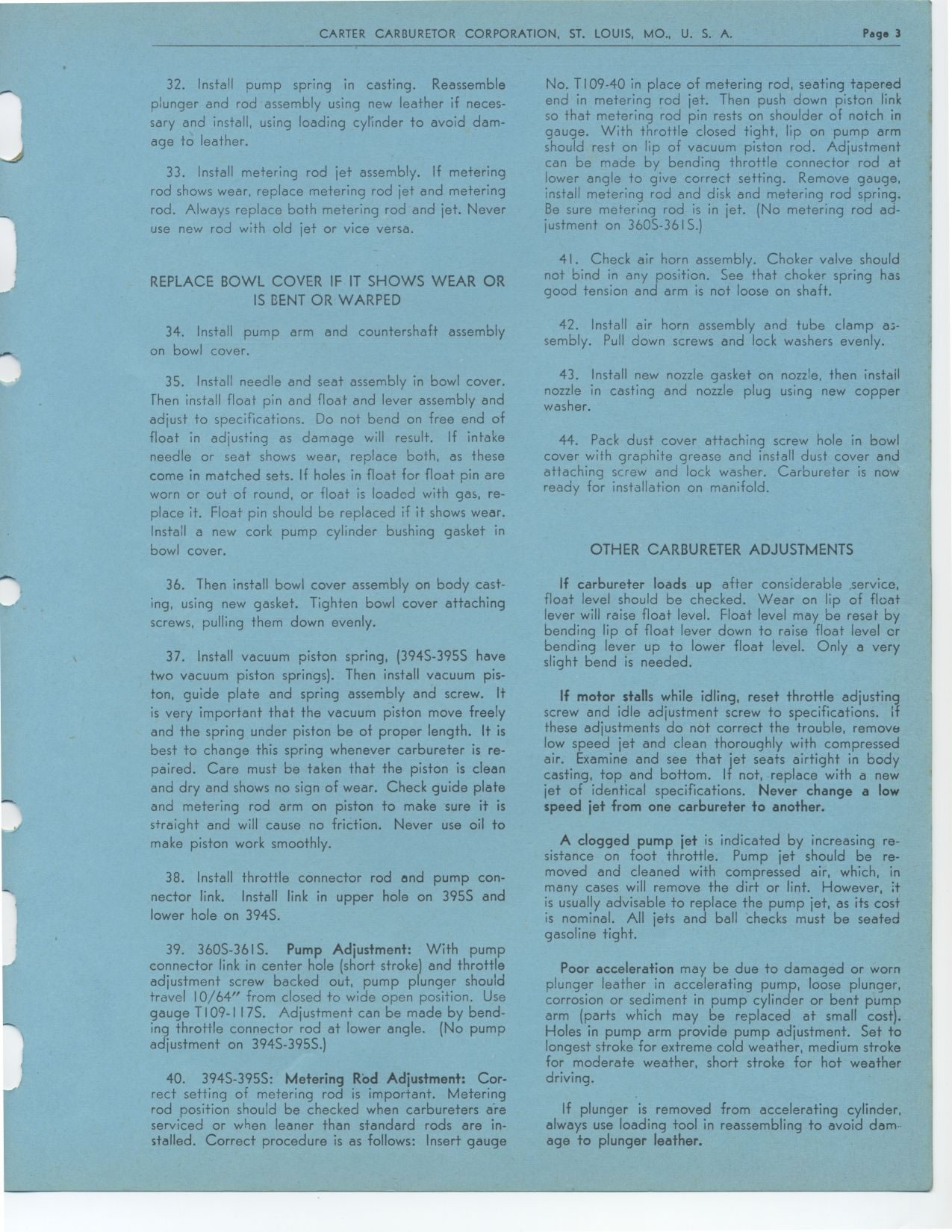|

CARTER CARBURETOR CORPORATION, ST. LOUIS, MO., U. S. A. Page
3
32. Install pump spring in casting. Reassemble plunger and rod assembly using
new leather if necessary and install, using loading cylinder to avoid dam-age
to leather.
33. Install metering rod jet assembly. If metering rod shows wear, replace
metering rod jet and metering rod. Always replace both metering rod and jet.
Never use new rod with old jet or vice versa.
REPLACE BOWL COVER IF IT SHOWS WEAR OR
IS BENT OR WARPED
34. Install pump arm and countershaft assembly on bowl cover.
35. Install needle and seat assembly in bowl cover. Then install float pin
and float and lever assembly and
adjust to specifications. Do not bend on free end of float in adjusting as
damage will result. If intake
needle or seat shows wear, replace both, as these
come in matched sets. If holes in float for float pin are worn or out of
round, or float is loaded with gas, re-
place it. Float pin should be replaced if it shows wear. Install a new cork
pump cylinder bushing gasket in
bowl cover.
36. Then install bowl cover assembly on body casting, using new gasket. Tighten
bowl cover attaching
screws, pulling them down evenly.
37. Install vacuum piston spring, (394S-395S have two vacuum piston springs).
Then install vacuum pis-
ton, guide plate and spring assembly and screw. It is very important that
the vacuum piston move freely and the spring under piston be of proper length.
It is best to change this spring whenever carbureter is re-paired. Care must
be taken that the piston is clean and dry and shows no sign of wear. Check
guide plate
and metering rod arm on piston to make sure it is straight and will cause
no friction. Never use oil to
make piston work smoothly.
38. Install throttle connector rod and pump connector link. Install link
in upper hole on 395S and lower hole on 394S.
39. 3605-361 S. Pump Adjustment: With pump connector link in center hole
(short stroke) and throttle adjustment screw backed out, pump plunger should
travel 10/64" from closed to wide open position. Use gauge T109- 117S.
Adjustment can be made by bending throttle connector rod at lower angle.
(No pump adjustment on 394S-395S.)
40. 394S-395S: Metering Rod Adjustment: Correct setting of metering rod is
important. Metering rod position should be checked when carbureters are serviced
or when leaner than standard rods are in-stalled. Correct procedure is as
follows: Insert gauge
No. T109-40 in place of metering rod, seating tapered end in metering rod
jet. Then push down piston link so that metering rod pin rests on shoulder
of notch in gauge. With throttle closed tight, lip on pump arm should rest
on lip of vacuum piston rod. Adjustment can be made by bending throttle connector
rod at lower angle to give correct setting. Remove gauge, install metering
rod and disk and metering rod spring. Be sure metering rod is in jet. (No
metering rod adjustment on 360S-361S.)
41. Check air horn assembly. Choker valve should not bind in any position.
See that choker spring has good tension and arm is not loose on shaft.
42. Install air horn assembly and tube clamp a:;-sembly. Pull down screws
and lock washers evenly.
43. Install new nozzle gasket on nozzle, then instail nozzle in casting and
nozzle plug using new copper washer.
44. Pack dust cover attaching screw hole in bowl cover with graphite grease
and install dust cover and attaching screw and lock washer. Carbureter is
now ready for installation on manifold.
OTHER CARBURETER ADJUSTMENTS
If carbureter loads up after considerable service, float level should be
checked. Wear on lip of float lever will raise float level. Float level may
be reset by bending lip of float lever down to raise float level cr bending
lever up to lower float level. Only a very slight bend is needed.
If motor stalls while idling, reset throttle adjusting screw and idle adjustment
screw to specifications. if these adjustments do not correct the trouble,
remove low speed jet and clean thoroughly with compressed air. Examine and
see that jet seats airtight in body casting, top and bottom. If not, replace
with a new jet of identical specifications. Never change a low speed jet
from one carbureter to another.
A clogged pump jet is indicated by increasing resistance on foot throttle.
Pump jet should be re-moved and cleaned with compressed air, which, in many
cases will remove the dirt or lint. However, it is usually advisable to replace
the pump jet, as its cost is nominal. All jets and ball checks must be seated
gasoline tight.
Poor acceleration may be due to damaged or worn plunger leather in accelerating
pump, loose plunger, corrosion or sediment in pump cylinder or bent pump
arm (parts which may be replaced at small cost). Holes in pump arm provide
pump adjustment. Set to longest stroke for extreme cold weather, medium stroke
for moderate weather, short stroke for hot weather driving.
If plunger is removed from accelerating cylinder, always use loading tool
in reassembling to avoid dam-age to plunger leather.
|
